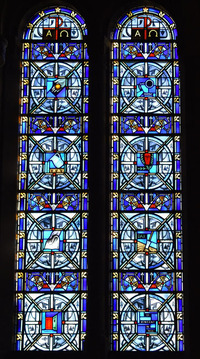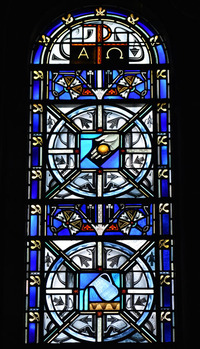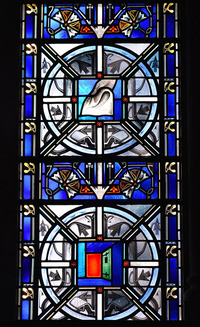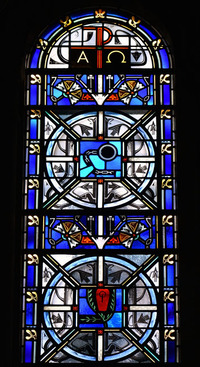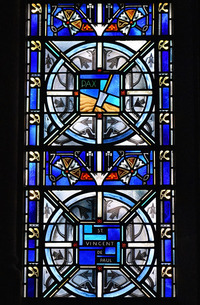Window
Building Name: The Presentation of the Blessed Virgin Mary ChapelStudio Name: Emil Frei Associates, Inc.
City: Livonia
Window Shape: 5 (gothic arched, 2 vertical sections)
Subject/Title of Window: The Seven Corporal Works of Mercy
Brief Description of Subject: This two lancet aisle window is located on the gospel side of the Felician Sisters Chapel. All aisle windows and transept windows have the same basic pattern, two lancet windows, the top symbol in each lancet sets the topic for that lancet, and the four symbols below are each encased in a geometrical shape surrounded by grisaille glass. The border and filler color used, like the geometric shape, is unique to the section of the Chapel they are located in --- the Felician Sisters Chapel uses a circle shape and the color of blue.
Corporal works of mercy can be found in the Old Testament as well as the New Testament. Jesus spoke of many of these in his parable about the Last Judgement. (Matthew 25:31 - 46).
Left lancet, top to bottom.
Seen at the top are a Chi Rho (Christ) and the Alpha and the Omega (God). Together they form an early symbol for Jesus being coeternal with God the Father.
Feed the Hungry: Symbolized by hand stretching forth with food.
Give Drink to the Thirsty: Symbolized by a pitcher, inscribed with a Greek cross, pouring water.
Clothe the Naked: Symbolized by a hand offering cloth.
Shelter the Homeless: Symbolized by an open door.
Right lancet, top to bottom.
This top is the same as the top of the left lancet.
Visit the Imprisoned: Symbolized by a ball and chain.
Visit the Sick: Symbolized with olive branches and an urn inscribed with an O l (Oleum). In administering to the sick, the priest anoints the patient with oleum infirmorum (oil of the sick). It is olive oil that has been blessed by a bishop.
Bury the Dead: Symbolized with a shovel thrust into the ground. Also seen is the Latin word for peace (PAX). This references a short prayer for the dead:
Eternal rest, grant unto him/her/them, O Lord,
And let perpetual light shine upon him/her/them.
May he/she/they/ rest in peace.
There are only seven Corporal Works of Mercy, this section highlights St. Vincent de Paul (1581 - 1660) who devoted his life to helping the poor. He founded the Vincentians, and, with St. Louise de Marillac, the Daughters of Charity. From the Vincentian Pledge, " We promise to do all we can to make Christ's Law of Love prevalent among all men and women, practicing the spiritual and corporal works of mercy."
Although the exact date is unknown, this window was in place by 1944.
Height: 11'
Width: 6'
The Seven Corporal Works of Mercy
Chi Rho, Alpha & Omega, Feed the Hungry, Give Drink to the Thirsty
Clothe the Naked, Shelter the Homeless
Chi Rho, Alpha & Omega, Visit the Imprisoned, Visit the Sick
Bury the Dead, St. Vincent de Paul
The MSGC is a constantly evolving database. Not all the data that has been collected by volunteers has been sorted and entered. Not every building has been completely documented.
All images in the Index are either born-digital photographs of windows or buildings or are scans of slides, prints, or other published sources. These images have been provided by volunteers and the quality of the material varies widely.
If you have any questions, additions or corrections, or think you can provide better images and are willing to share them, please contact donald20@msu.edu

